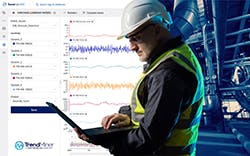Software AG Introduces TrendMiner 2021.R2
Software AG’s TrendMiner releases TrendMiner 2021.R2. The new release reportedly extends the reach of previously released notebook integration, allowing analytics expert users to make their data model outputs available to the rest of the organization. The new multi-variate anomaly detection model allows optimal process conditions to be trained on historical data and the model can detect anomalies on new incoming data. TrendMiner 2021.R2 now allows self-service integration via webMethods.io. This enables contextual process information from other business applications to be taken into account and workflows in external systems to be triggered through the new anomaly detection model.
TrendMiner enables operational experts in process manufacturing industries to analyze, monitor and predict operational performance using sensor-generated time-series data. TrendMiner’s goal is to empower engineers with analytics for improving operational excellence without the need to rely on data scientists. It brings data science to the engineers.
TrendMiner 2021.R2 notebook capabilities can be operationalized by deploying custom-created data models into an embedded scoring/inference engine through use of machine learning model tags. These machine learning model tags are available for all TrendMiner users, as if they were tags originating from an enterprise historian or any other time-series data source. All existing TrendMiner capabilities can be applied, such as visualizing recent and historical data, searching for patterns or threshold values as well as monitoring using the machine learning model patterns.
The TrendMiner 2021.R2 release offers a proprietary model for multi-variate anomaly detection via the mentioned notebook and machine learning model tags functionality. The TrendMiner anomaly detection model can be trained on a trend view containing normal process operating conditions. After learning the desired process conditions, the model can detect anomalies on new incoming data. The model will return information as to whether a new datapoint is an outlier based on a given threshold (anomaly class) or return an anomaly score. The higher the anomaly score, the more likely it is that the datapoint is an outlier.
